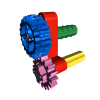Search the Community
Showing results for tags 'Traction'.
Found 7 results
-
This is my own creation of a Mercedes-Benz G550 4x4² SUV. Check out my Rebrickable post for instructions which you can download for free: https://rebrickable.com/mocs/MOC-43865/BrickHugger171/mercedes-benz-g550-4x42/?inventory=1#comments
-
Hi all, I've been working on a 2-8-0 locomotive with Big Ben Bricks' small drivers and Zephyr's connecting rods. It is tender driven, meaning there is very little weight in the loco itself, and as a result the driving wheels stutter every so often. I have reduced the friction as much as I can but there is still a noticeable loss of traction. The loco is just too light. I've looked at official lego weights and they're far too big to fit in the build. Are there any non-lego alternatives that I could hide somewhere in a hollow section of the body? Any suggestions or help will be appreciated. Thanks! An image for reference. Taken before the connecting rods arrived:
-
Hey guys! I've been playing with the idea of implementing a terminus station into my layout. This would mean that trains need to reverse out of the station and in the best case drive around normally in reverse with a cab at the non-powered control car at the end. See this picture for explanation: I've noticed that by pushing, the Lego train engines seem to struggle a bit more with higher loads than while pulling. I don't understand why this is the case though. Physically, the forces should be the same, no? Maybe I'm missing something. Obviously I could just put an engine at either end of the train but I'm trying not to in order to have more independent trains running around. A push-pull train is very common in Germany for example (where I live). That's where I got the idea from.
-

[MOC] Waving goodbye to 2016 with this little RWD drift car!
896gerard posted a topic in LEGO Technic, Mindstorms, Model Team and Scale Modeling
As a last goodbye to 2016, I present this small red car. It is not really built to be particularly good looking (I used a wire bodywork to have a low weight) or to have a particular high speed. But what it does, is put a smile on your face. Technics are kept simple, there's an RC buggy motor next to a PF lipo batterybox in the middle, a PF medium steering motor before the front axle and an IR V2 receiver to enable 1 metre of infrared range when going outside. Please Lego... Please... do something about it. The frustration and anger about this appalling range is powering companies like S-brick. And that's why my future cars are having an S-brick, leaving this model as one of my last PF IR remote controlleds MOCs... We're making a fun car, right? So there is a silly spoiler and huge rear tires. By the way, these wide tires provide excellent traction in dry conditions, which is important for low-weight cars like this. The interior had to be sacrificed to have a low position for the drive motor and battery box. Because of this measure, the handling was quite good, but made much worse by the slow PF IR remote. In the end, of course there is the video: The longer story can be read on MOCpages and better photos are on Brickshelf. Have a nice 2017! -
Some time ago this thread appeared, talking about a substance called "Bullfrog SNOT": After some initial confusion (is this some sort of new building technique?), I learned it was some sort of substance model railroaders could "paint" onto their wheels to add traction. I was pretty sure that it would just be worse than an actual traction tire, and forum posts reviewing the substance seemed to agree with me. The train wheels Lego makes both feature a groove for traction tires already anyway. However, I had been considering a couple things I wanted to model where the correct wheel size is closer to a Big Ben Bricks medium wheel. I didn't trust myself to cut a groove into the wheels without access to proper machine tools, so I thought I'd try the "painted on" traction tires. One key issue, however: I'm kind of a cheapskate, and didn't want to spend $25 on a tiny container of stuff to find out how well it worked. Furthermore, if it did work, and I posted about it, forum members who aren't from the only country to put men on the moon might have difficulty accessing the substance (although Tenderlok seems to have managed somehow). Time to find a substitute. Whatever I found needed to have the following properties: Increase friction (adds traction). Can be applied in a uniform layer. Transparent, so it doesn't affect the appearance of the wheel it's applied to. What has these properties, and is readily available? Urethane caulk from a hardware store! However, caulk is far too thick to apply evenly in a thin layer. The packaging bears the words "easy soap and water clean up"; I took this to mean that I could thin it by adding a small amount of water: I then used a small brush to apply this onto a clean spinning wheel to get an even coating: I left the wheel spinning for about half an hour for the thinned caulk to dry. Here's what it looked like afterwards: I built a small test vehicle and ran it on a figure-eight for about half an hour (so as to test it going around turns both ways). This was the result: legoman666 is remarkably prescient... Pressing down on the test vehicle suggested that the painted-on tire had a bit less traction than an actual traction tire, but traction seemed to remain reasonable after a half hour of running. I wanted a more thorough test though, so Commander Wolf installed the modified wheels on his QJ and had it pull some long cars for most of a BayLUG meeting. The result: This stress-testing caused the tires to wear off. I'm not sure if that's a property of the substance (did I thin it too much?), or perhaps the underlying surface being too smooth for the caulk to adhere well. More testing is in order...
- 9 replies
-
- experiment
- big ben bricks
-
(and 1 more)
Tagged with:
-

[MOC] RWD Car with Mechanical Traction Control
896gerard posted a topic in LEGO Technic, Mindstorms, Model Team and Scale Modeling
Four wheel drive on Lego Technic cars with small wheels is hard to realize, as they become relatively too wide (which is ugly) and the ground clearance is also compromised. The problem then is: how to get the same grip back with only rear wheel drive? Then you need to push something 'extra' in the back of your already crammed, small nice-looking vehicle... This concept is an approach to keep this 'something extra' as small as possible while giving awesome and unexpected grip to the car. (At least, I was astonished by what it achieved!) Instead of typing a lot, I've put it all into a video with the theory of how it all works at the back of the video to let the 7 billion minus 1000 viewers that are not interested into more advanced Technic stuff experience how it works in practice on a 2 cm (that is: inchy) thick ice floor. As for the car, it is built from Power Functions spares as all my L-motors (which have quickly become the main workhorse for every Technic builder) are ehm... in use. That is why you find me using a geared up XL motor, which gave me memories of the good old times when the poor knob wheel parts splattered around. Sharp images of the car and mechanism explanation can be found on: http://www.brickshel...ry.cgi?f=564319. On MocPages (beware, there is a piece of code there that simply destroys anything such as image resolution on .png files...) http://www.moc-pages.../moc.php/428881 Video: I finally have found PovRay so (with many thanks to all those who make that software) I can present a high-quality render: -
Hi all, Currently im building a Lego City layout with PF trains. What i want is build a ramp for my trains, to get the trains to another level on the layout, which is around 13 bricks higher. There are some guides on ramps, but i don't have enough space for those layout, since then it will be longer then my actual table. When i did some test runs, i've noticed that my trains don't make it. The issue is not that they are not powerful enough, but they lose traction on the smooth plastic PF track, spin out and when stopped they roll down again. So what im interested in, is if someone has any ideas on how to add traction to the track (preferable without damaging the track). What is i thought of was: 1. use old 12v track, since its not smooth, but has compatibility issues. 2. Apply rubber to the track, but not sure how. 3. use sandpaper to make the track rougher, but damaging the track. Not sure if it will work Does anyone has any good ideas on this topic?




